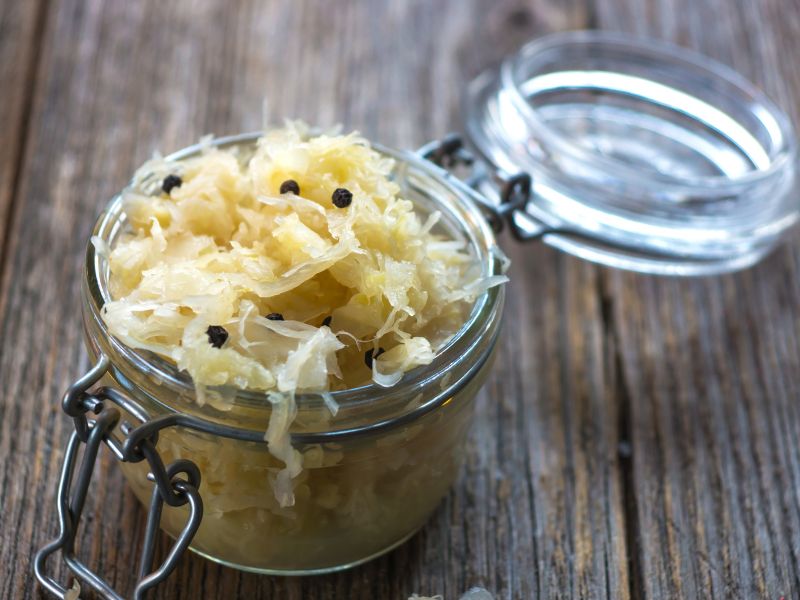Sauerkraut is a popular dish made from fermented cabbage that is commonly enjoyed as a side dish, topping, or ingredient in a variety of recipes. The tangy and sour taste of sauerkraut makes it a perfect accompaniment to a range of meats, sandwiches, and hot dogs. If you’ve recently made or purchased a large batch of sauerkraut, you might be wondering if you can freeze it for later use.
What Is Sauerkraut?
Sauerkraut is typically made by fermenting shredded cabbage in a brine solution with salt and other ingredients like herbs, spices, or vinegar. During the fermentation process, the natural bacteria on the cabbage convert the sugars in the cabbage into lactic acid, which gives sauerkraut its distinctive tangy flavor and helps to preserve it.
Benefits of sauerkraut: Sauerkraut is packed with nutrients like vitamins C and K, as well as fiber and probiotics, which can promote gut health and boost the immune system.
Tips for making sauerkraut at home:
- Use fresh cabbage and avoid any bruised or damaged leaves.
- Clean and sanitize all equipment and surfaces before preparing the sauerkraut.
- Be precise with the measurements of salt and other ingredients to ensure proper fermentation.
- Allow the sauerkraut to ferment in a cool and dark place for at least a week before tasting or refrigerating it.
Can You Freeze Sauerkraut?
Short answer: Yes, you can freeze sauerkraut for later use.
However, there are some factors to consider before freezing sauerkraut. The texture and flavor of sauerkraut can change after freezing and thawing, so it may not be the same as fresh sauerkraut. Additionally, sauerkraut contains live bacteria and enzymes that are essential for its fermentation and nutritional benefits. Freezing can kill some of these microorganisms and impact the quality of the sauerkraut.
Best practices for freezing sauerkraut:
- Use fresh sauerkraut that has not been previously frozen or canned.
- Store sauerkraut in an airtight container or freezer-safe bag to prevent freezer burn and contamination.
- Label the container or bag with the date and contents for easy identification.
- Use a vacuum sealer to remove as much air as possible from the container or bag to reduce the risk of freezer burn.
- Freeze sauerkraut as soon as possible after preparing or purchasing it to preserve its freshness.
How to Freeze Sauerkraut
Step-by-step guide for freezing sauerkraut:
- Prepare the sauerkraut according to your recipe or preference.
- Cool the sauerkraut to room temperature.
- Transfer the sauerkraut to an airtight container or freezer-safe bag.
- Label the container or bag with the date and contents.
- Remove as much air as possible from the container or bag using a vacuum sealer or by pressing out the air.
- Place the sauerkraut in the freezer.
Materials needed:
- Airtight container or freezer-safe bag
- Label or marker
- Vacuum sealer (optional)
Tips for effective freezing:
- Freeze sauerkraut in small batches or individual servings for easier thawing and portion control.
- Avoid overfilling the container or bag, as sauerkraut may expand during freezing.
- Use a freezer with a consistent temperature to maintain the quality of the sauerkraut.
Thawing Sauerkraut
Importance of thawing sauerkraut properly:
Thawing sauerkraut incorrectly can lead to the growth of harmful bacteria or alter the texture and flavor of the sauerkraut.
Different ways to thaw sauerkraut:
- Refrigerator: Thaw sauerkraut in the refrigerator by transferring it from the freezer to the fridge and allowing it to thaw overnight or for several hours.
- Room temperature: Thaw sauerkraut at room temperature by placing the container or bag in a bowl of cold water and changing the water every 30 minutes until the sauerkraut is thawed.
- Microwave: Thaw sauerkraut in the microwave using the defrost setting.
Tips for thawing sauerkraut:
- Do not refreeze sauerkraut once it has been thawed.
- Thaw sauerkraut in the fridge or room temperature rather than the microwave to preserve its texture and flavor.
- Use thawed sauerkraut within 2-3 days to prevent spoilage.
Using Frozen Sauerkraut
Cooking frozen sauerkraut:
Frozen sauerkraut can be used in a variety of dishes, including stews, casseroles, and sausages. However, it is important to note that the texture and flavor of frozen sauerkraut may be slightly different than fresh sauerkraut.
Incorporating frozen sauerkraut into recipes:
Here are some recipe ideas for using frozen sauerkraut:
- Slow cooker pork and sauerkraut
- Sausage and sauerkraut skillet
- Reuben casserole
How frozen sauerkraut compares to fresh sauerkraut:
While frozen sauerkraut can be a convenient option for those who want to preserve their homemade or store-bought sauerkraut, it is important to keep in mind that it may not be the same as fresh sauerkraut in terms of texture and flavor. Freezing can cause the sauerkraut to lose some of its crunchiness, and it may taste slightly different due to changes in its chemical composition.
Despite these differences, frozen sauerkraut can still be a great option for those who want to enjoy sauerkraut year-round or have a surplus of sauerkraut that they want to preserve for later. By following the proper steps for freezing and thawing, as well as incorporating frozen sauerkraut into recipes that complement its texture and flavor, you can enjoy the benefits of sauerkraut in all seasons.
Conclusion
In conclusion, freezing sauerkraut is a great way to preserve this tasty and nutritious food for later use. By following the steps outlined above for freezing, thawing, and using frozen sauerkraut, you can ensure that your sauerkraut maintains its quality and safety. While frozen sauerkraut may not be exactly the same as fresh sauerkraut, it can still be a valuable ingredient for a variety of dishes. So go ahead and stock up on sauerkraut – you can enjoy its tangy flavor all year long!





